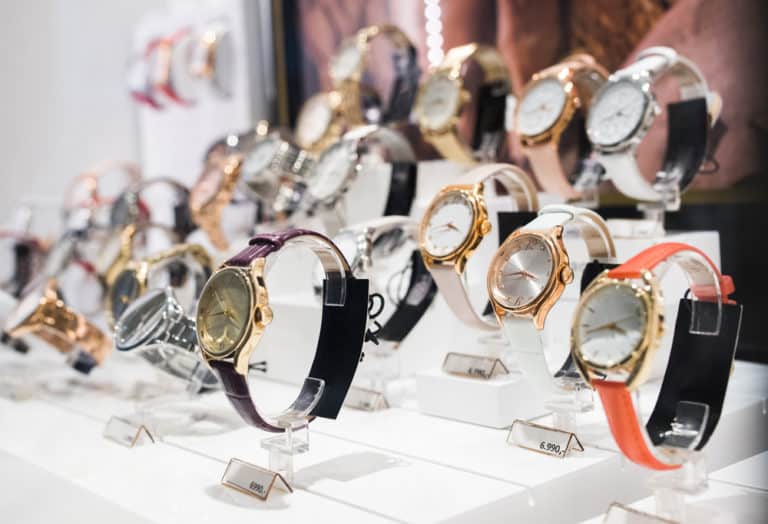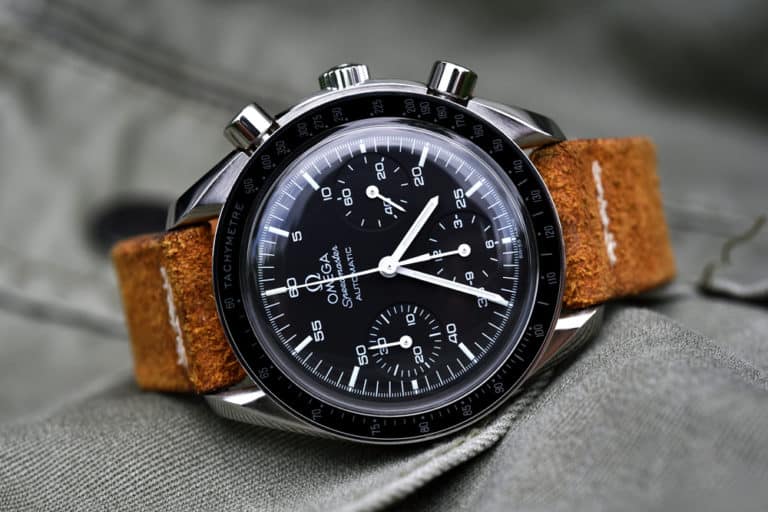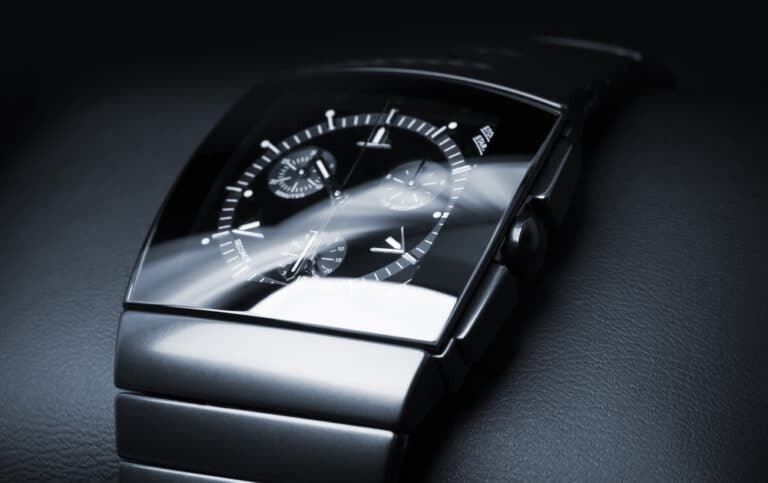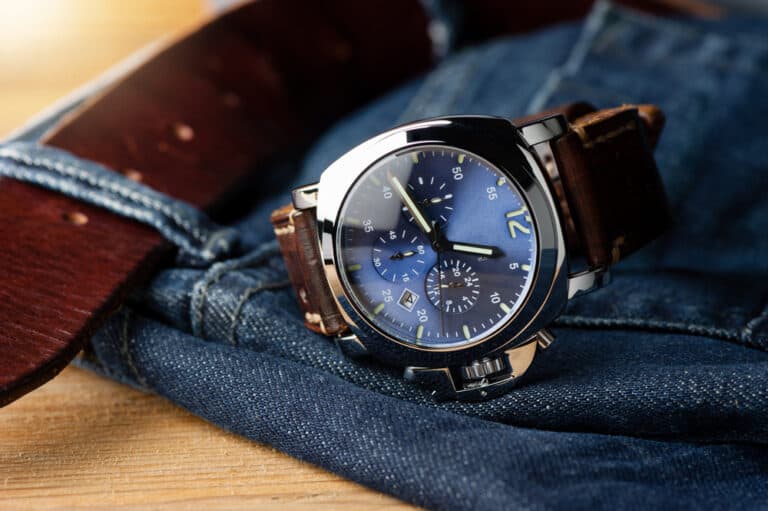Editorial credit: Evannovostro / Shutterstock.com
We live in an age where watches are no longer worn to tell the time but as fashion accessories or even status symbols. Watches can be manufactured from various materials, with two of the most common watch materials being ceramic and stainless steel. Although they may look the same, ceramic and steel are very different. So which one is better for watches?
Ceramic watches are scratch-proof and resistant to corrosion in harsh environments. They are more lightweight than steel and very comfortable to wear. Ceramic won’t bend or dent, but it is not shatter-proof like stainless steel. Ceramic watches are more expensive but retain their luster longer than steel.
Everyone has different preferences when it comes to what you wear around your wrist. Choosing between a ceramic or steel watch will be easier when you know how they compare in terms of durability, comfort, cost, and style.
What Type Of Ceramic Is Used In Watches?
Ceramic doesn’t contain any metals in its pure form. Ceramics are solid inorganic materials consisting of raw materials like clay that have been hardened by heat. Ceramics are used to make a variety of items ranging from kitchenware and pottery to building materials like glass, cement, and tiles.
Ceramics used in watchmaking differ from the ceramics used in other everyday items. Watches are made using a unique form of ceramic, referred to as high-tech ceramic. High-tech ceramics contain metals like titanium or iridium, making them more durable by increasing their hardness and ability to withstand high temperatures. Some watch brands, like Rolex, combine the ceramic powder with metals like gold to create a stronger, more durable material than ceramic by itself.
Ceramics can be used in many different parts of the watch but should ideally be used in components that need to stay free from scratches, corrosion, and heat damage. These include all the external components like the bracelet, bezel, and watch case.
What Is The Best Type Of Steel For Watches?
You may have noticed that some stainless-steel watches are more expensive than others, even though they appear to be made of the same material. The type of stainless steel used in the watch determines its quality and will reflect on the price tag. Top-quality luxury watches contain a higher grade of stainless steel with characteristics that make them far superior to low-end watches made with lower-grade stainless steel alloys.
Grade 304 Stainless Steel
Low-grade stainless steel is easy to manufacture and shape into products and is, therefore, the most affordable steel. The most commonly used stainless steel is type 304. Most of the stainless-steel items in your house, including your kitchenware, appliances, tools, etc., are 304 stainless steel. But it’s not the best material to use in watches because it is prone to corrosion. Watches made with type 304 steel are usually low-end and, unfortunately, won’t last very long before it starts showing some damage.
Grade 316L Stainless Steel
Most high-end watches are made with type 316L stainless steel. Grade 316L stainless steel is similar to grade 304L stainless steel in composition, being an alloy of nickel, chromium, and iron, but it has the addition of molybdenum and contains less carbon than lower-grade stainless steel. 316L stainless steel has a higher corrosion resistance when exposed to acids and chlorides and remains stable in high-temperature conditions. Grade 316L stainless steel resists magnetic forces and is ideal for making high-end diving watches.
Grade 904L Stainless Steel
The highest grade and most expensive stainless steel is grade 904L stainless steel. It is considered a super-alloy because it contains more chromium, nickel, and molybdenum than lower-grade steel. It has an extremely high resistance to corrosion due to the elements copper, manganese, and silicon and is also hypoallergenic.
Grade 904L stainless steel is very durable but involves a lot more processing than lower-grade steel. Grade 904L stainless steel comes at a much higher price and is only used in high-end luxury watches like Rolex, which gives the RX watches their unique polished finish.
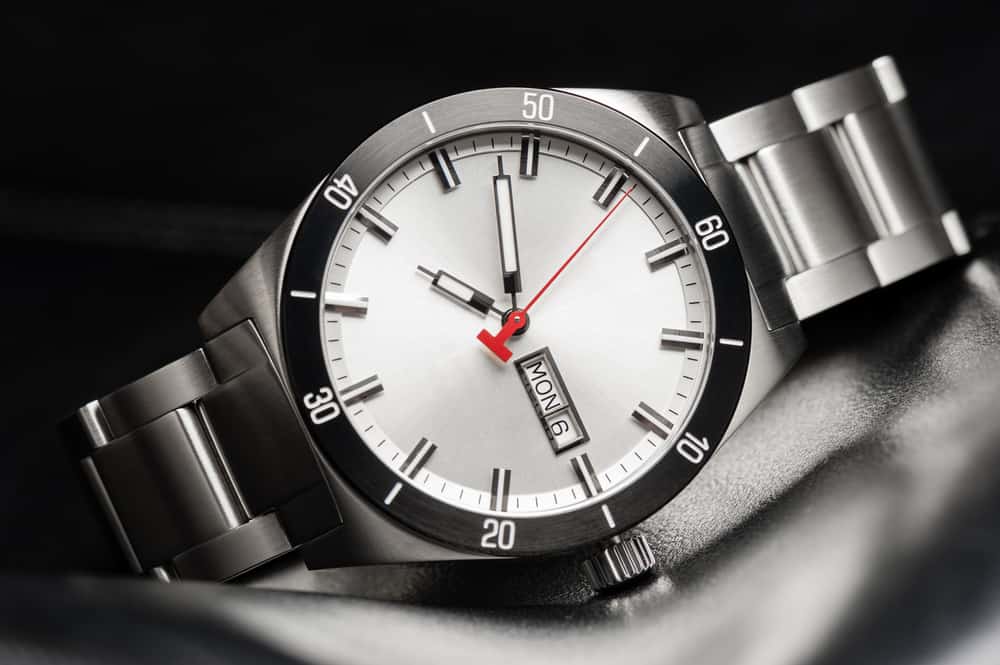
Ceramic Watches Vs. Stainless Steel Watches
High-end watches have become more popular in the last decade, but with the extensive range of watches available, it becomes difficult to know which is the better investment. Below we listed important qualities of both ceramic and stainless watches so that you can make an educated decision when you want to purchase your own.
1. Hardness
Ceramics have incredible hardness and are much harder than stainless steel. Although stainless steel isn’t the hardest material available in watchmaking, it is much harder than other metals, including sterling silver and gold.
2. Resistance To Scratching
When it comes to scratch resistance, ceramic wins again. Ceramic watches are completely scratch-proof and retain their shine for a long time. Stainless steel watches will inevitably scratch with regular wear and require polishing if you want them to look clean and new.
3. Weight And Comfort
Unlike stainless steel and other metals, ceramic is a very lightweight material, so your watch won’t feel heavy and uncomfortable on your wrist as the day passes. Ceramic also has a very smooth surface and offers a luxurious, stylish look without compromising comfort. Stainless steel watches are heavier than ceramic ones, making them slightly less comfortable.
4. Resistance To Corrosion Or Rust
Ceramic has a very stable chemical composition that prevents oxidation when exposed to strong chemicals, acids, or seawater. An important property that makes ceramic stand out above other materials, including steel, is that it does not rust or corrode even in the harshest environments. This property makes ceramic an ideal material for diving watches.
5. Resistance To Fading Or Discolouration
One of the reasons ceramic watch is expensive is that they are durable and keep their color and shine for a lifetime. Ceramic does not fade when exposed to sunlight, and the color does not wear off when the watch is exposed to the elements. Stainless steel will last a long time, but it can tarnish or fade over time, especially when exposed to harsh environments.
6. Hypoallergenic Properties
Ceramic does not contain any metals that may irritate the skin and is the perfect type of watch for you if you have allergy-prone skin or react badly to metals. Not all types of stainless steel are hypoallergenic. It depends on the alloys used to make the steel and the grade of stainless steel. Higher grades of stainless steel are the best options if your skin is sensitive to certain elements.
7. Resistance To Cracks Or Breakage
Ceramic has so much going for it, except that it is not shatter-proof. Ceramic cannot withstand impact and can crack or shatter with impact against a hard surface. All its other advantages make it well worth the price, as long as you take care not to accidentally bump it against something or drop it on the ground. Despite being fragile to splintering, ceramic won’t easily dent or bend like metals.
8. Exposure To High Temperatures
Ceramic watches do not absorb heat from the sun, so your wrist won’t end up burning if you stand in the sun for long periods. Grade 304, 316L, and 904 stainless steel do well in high-temperature environments, but unlike ceramic, steel is not entirely heat-resistant and will heat up eventually when exposed to very high temperatures for extended periods.
Are Ceramic Watches More Expensive Than Steel Watches?
The engineering of ceramic watches is an intricate and arduous process. Ceramic has to go through a heating, cooling, and molding process and also requires polishing so that the surface is smooth and shiny. Due to the time-consuming manufacturing process, ceramic watches tend to be more expensive than steel watches.
Conclusion
Both ceramic and stainless steel are used to manufacture high-end luxury watches. When it comes to choosing between the two, it will depend on what you need in a watch. Ceramic watches are a good investment if you’re looking for the best long-term option. Ceramic watches may be more expensive, but they last longer than steel, are completely heat-resistant and corrosion-resistant, and won’t discolor or scratch.
References
- https://www.swisswatchexpo.com/TheWatchClub/2019/04/12/pros-and-cons-of-ceramic-in-watches/
- https://www.govbergwatches.com/blog/govberg-ceramic-watches.html
- https://www.livwatches.com/blogs/everything-about-watches/ceramic-vs-steel-bezels
- https://www.gnomonwatches.com/blogs/news/watch-materials
- https://gorilla-fitnesswatches.com/ceramic-vs-stainless-steel-watch/
- https://www.megalithwatch.com/blogs/watch-knowledge/ceramic-watches-pros-and-cons
- https://www.ablogtowatch.com/watch-case-materials-explained-ceramic/
- https://wristporn.com/ceramic-watches-should-you-buy-them-ceramic-watches-guide/
- https://www.firstclasswatches.co.uk/blog/2021/11/what-is-a-ceramic-watch/
- https://quillandpad.com/2015/10/30/understanding-ceramics-now-used-for-watch-cases/
- https://www.bobswatches.com/rolex-blog/resources/ceramic-vs-steel-bezels-pros-and-cons-2.html
- https://www.grayandsons.com/blog/tough-fine-timepieces-why-ceramic-watches-popular/
- https://www.fratellowatches.com/difference-between-316l-and-904l-stainless-steel/
- https://newsroom.posco.com/en/need-know-stainless-steel-wristwatch/
- https://www.reliance-foundry.com/blog/does-stainless-steel-rust

